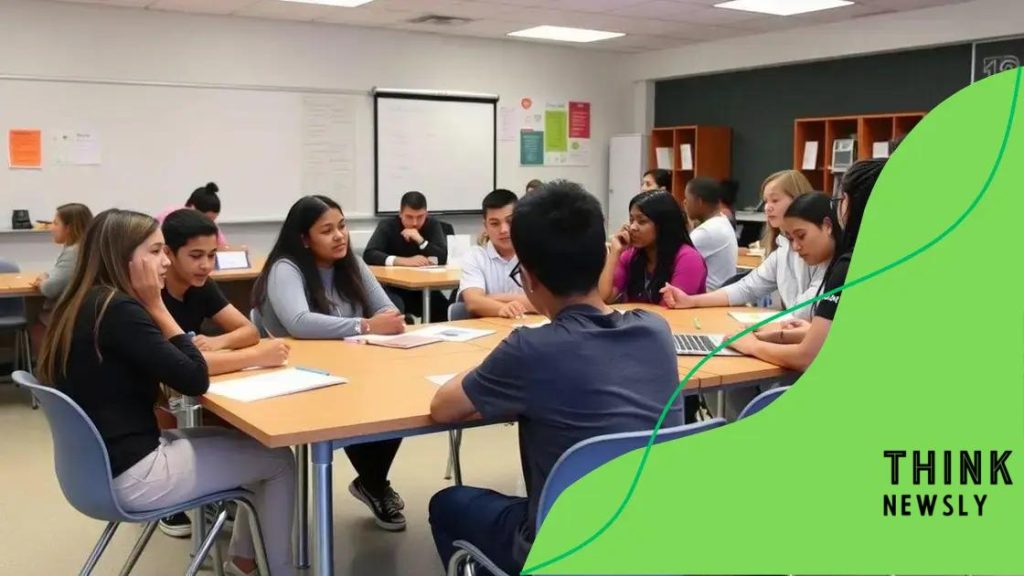Student-led learning models: Empowering education today

Anúncios
Student-led learning models empower students to actively participate in their education, fostering engagement, critical thinking, and collaboration while switching the focus from traditional teacher-centered approaches.
Student-led learning models are reshaping the education landscape, inviting students to take charge of their learning. Have you ever considered how this approach fosters independence and critical thinking? In this article, we’ll dive into what these models entail and explore their impact on the classroom.
Anúncios
Understanding student-led learning models
Understanding student-led learning models is essential for educators who wish to foster an engaging classroom environment. These models place students at the center of the learning process, encouraging them to take control of their educational journey.
Defining student-led learning models
In essence, student-led learning models empower learners to actively participate in their education. This approach allows students to make choices about their learning, including selecting topics, resources, and the pace of the lessons. By doing so, they become invested in their own education.
Key characteristics of student-led learning
These models often share several common characteristics that help in fostering a productive learning atmosphere:
Anúncios
- Choice: Students have the freedom to choose their learning paths.
- Collaboration: Peer interaction is encouraged, allowing for teamwork and knowledge sharing.
- Reflection: Students are asked to reflect on their learning experiences, enhancing their self-awareness.
Incorporating these elements not only engages students but also nurtures critical thinking and problem-solving skills. Student-led learning models also focus on nurturing a sense of responsibility and accountability among learners.
Benefits of embracing student-led approaches
Utilizing student-led learning models offers numerous benefits. By allowing students to take charge, they develop essential life skills such as leadership and decision-making. Moreover, this approach leads to increased motivation since students are more likely to engage in topics they have chosen personally. Additionally, it promotes deeper understanding as learners explore subjects more thoroughly.
In conclusion, understanding student-led learning models opens doors to innovative teaching practices. By embracing these approaches, educators can create a rich learning environment that not only respects student autonomy but also nurtures a love for learning.
Key benefits for students
Understanding the key benefits for students in student-led learning models is crucial for recognizing their power. These benefits extend far beyond traditional educational approaches, creating a more engaging and motivating atmosphere for learners.
Increased engagement
One of the primary advantages of student-led learning models is heightened engagement. When students take control of their learning, they are more likely to participate actively. This involvement leads to a deeper interest in the subject matter and fosters curiosity about the world around them.
Development of critical skills
These models also promote essential skills that are valuable in both academic and life settings. Students develop:
- Leadership: By taking charge of their learning, students learn to lead discussions and group projects.
- Decision-making: Choosing how to approach a topic requires careful consideration and strategy.
- Collaboration: Working with peers helps students learn to communicate and solve problems together.
This skill set is not just about academics; they are transferable to future jobs and personal situations.
Enhanced self-confidence
Another benefit is improved self-confidence. When students see that their choices lead to successful learning outcomes, they feel more assured. This boost in confidence encourages them to take on new challenges and pursue their interests more boldly.
As we explore further, it’s evident that student-led learning models have a profound impact on learners. By nurturing autonomy and responsibility, these approaches set students up for long-term success. Students equipped with these skills and confidence can navigate their educational journeys with purpose and passion.
Practical strategies for implementation

Implementing student-led learning models in the classroom can be transformative. However, it requires thoughtful strategies to ensure success. Educators can take specific steps to foster an environment where students thrive.
Encourage student choice
One effective strategy is to provide students with choices in their learning activities. By allowing them to select topics or projects that interest them, teachers can enhance engagement. Students have unique passions and interests; tapping into these can lead to greater investment in their education.
Facilitate collaborative learning
Another important approach is to promote collaborative learning. Group projects allow students to work together and learn from each other. In a collaborative setting, students can share ideas and develop new perspectives. This not only builds teamwork skills but also helps students feel connected to their peers.
- Group projects: Assign tasks that require teamwork to complete.
- Peer teaching: Let students teach each other about their strengths.
- Discussion circles: Facilitate small group discussions on key topics.
These activities help create a supportive community, making learning more enjoyable.
Establish a supportive environment
Creating a classroom environment that supports student-led learning is crucial. This includes setting clear expectations and providing guidance while giving students room to explore. Teachers should offer ongoing feedback and encouragement, helping students develop their ideas and pursue their interests. An inviting atmosphere where mistakes are viewed as learning opportunities will inspire students to take risks.
In summary, effective implementation of student-led learning models hinges on choice, collaboration, and support. By applying these practical strategies, educators can empower their students to take control of their own learning.
Case studies of success in classrooms
Exploring case studies of success in classrooms that use student-led learning models reveals valuable insights. These real-life examples show how this approach can transform education, fostering greater engagement and achievement among students.
Example 1: A middle school project-based learning initiative
At a middle school in California, teachers implemented a project-based learning initiative where students chose projects based on their interests. Students collaborated in small groups, conducting research and presenting their findings to the class. This model led to improved communication skills and increased confidence among students. The freedom to explore topics they loved made learning enjoyable and effective.
Example 2: High school led by peer teaching
A high school in New York adopted a peer teaching model where older students taught younger peers. This not only helped the younger students grasp difficult concepts but also reinforced the older students’ understanding of the material. The results were impressive: both groups showed improved grades and greater enthusiasm for learning.
- Student engagement: Higher participation rates were noted during sessions.
- Peer relationships: Stronger friendships formed as students worked together.
- Confidence boost: Older students gained leadership skills and confidence.
These classroom success stories underscore the effectiveness of student-led learning models in various educational settings. Teachers noticed that when students take charge of their learning, they become more responsible and invested in their education.
Example 3: A collaborative learning community
Another inspiring case comes from a rural school where teachers created a collaborative learning community. Through this model, students worked on interdisciplinary projects that combined multiple subjects. By leading discussions and making decisions as a group, students enhanced their critical thinking and problem-solving skills. Feedback from parents indicated that students were more eager to share what they learned at home.
As we observe these successful implementations, it becomes clear that student-led learning models can revolutionize how students approach their education, making learning a dynamic and engaging experience.
Challenges and how to overcome them
Implementing student-led learning models comes with its own set of challenges. Understanding these difficulties is the first step toward creating effective solutions. By recognizing common obstacles, educators can take proactive measures to encourage successful adoption.
Challenge 1: Resistance to change
Many educators are accustomed to traditional teaching methods that dictate how learning should occur. This resistance can make it difficult to embrace a new approach. Teachers may worry about losing control over the classroom and finding it hard to adapt their lesson plans. To overcome this, schools can provide professional development that showcases the benefits and effectiveness of student-led models. Encourage teachers to start small, allowing them to experiment with one aspect of student-led learning.
Challenge 2: Varying student readiness
Another challenge is that not all students may be prepared for increased autonomy. Some might struggle to take initiative, while others could dominate group discussions. To address this, teachers can implement structured frameworks for self-directed learning. This can include clear guidelines for projects and assigned roles within groups to ensure that every student engages. Providing scaffolding helps students build confidence in their abilities.
- Provide training: Offer workshops on skills needed for student-led learning.
- Set clear expectations: Guide students on what is expected in their roles.
- Use buddy systems: Pair more experienced students with those needing support.
With support, all students can participate meaningfully in their learning.
Challenge 3: Assessment difficulties
Assessing student progress in a student-led learning model can be complex. Teachers may struggle to evaluate projects that are more open-ended. Developing clear rubrics is essential. These rubrics provide transparency on how students will be evaluated. Including peer feedback in assessments can also enhance learning while ensuring that students develop reflective skills.
By addressing these challenges with effective strategies, educators can create an environment ripe for student-led learning. This change requires patience, practice, and ongoing evaluation, but the rewards of a more engaged classroom are well worth the effort.
FAQ – Frequently Asked Questions about Student-Led Learning Models
What are student-led learning models?
Student-led learning models empower students to take an active role in their education, allowing them to choose topics, work collaboratively, and engage in meaningful discussions.
How can teachers implement these models effectively?
Teachers can implement student-led learning by providing choices, fostering collaboration among peers, and creating a supportive environment with clear expectations.
What challenges might teachers face with student-led learning?
Common challenges include resistance to change, varying student readiness, and difficulties with assessment, but these can be addressed with training and structured frameworks.
What are the benefits of student-led learning for students?
Benefits include increased engagement, the development of critical skills, enhanced confidence, and improved overall academic performance as students take ownership of their learning.





